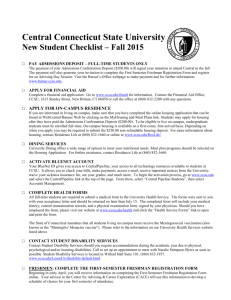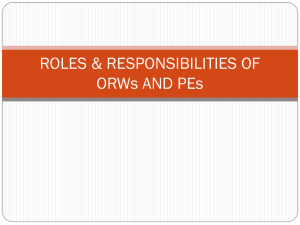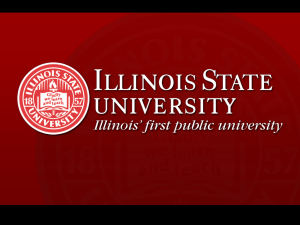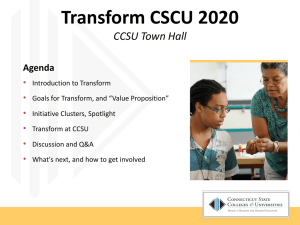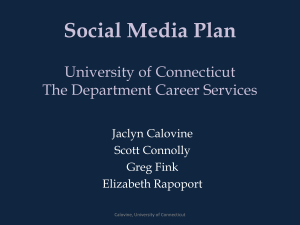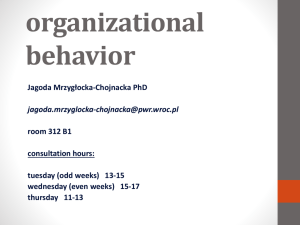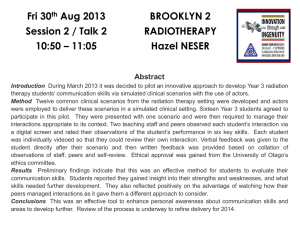Sightlines - Central Connecticut State University
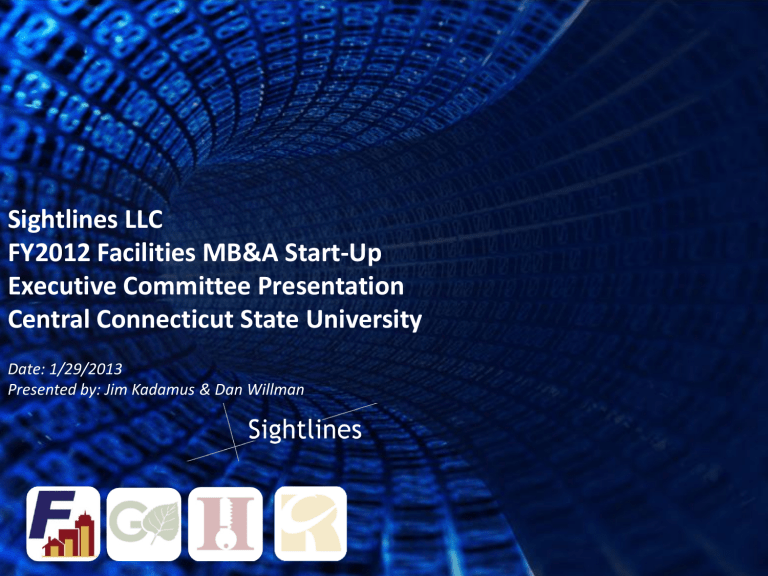
Sightlines LLC
FY2012 Facilities MB&A Start-Up
Executive Committee Presentation
Central Connecticut State University
Date: 1/29/2013
Presented by: Jim Kadamus & Dan Willman
1
Sightlines profile
Serving over 380 campuses in 41 states and Canada
• 12 year old company based in Guilford, CT
• Database of 23,500 buildings and 1.2 Billion GSF
• Sightlines’ process used at 17 ConnSCU campuses
• Also used by eight other state systems
2
A vocabulary for measurement
The Return on Physical Assets – ROPA SM
The annual investment needed to ensure buildings will properly perform and reach their useful life
“Keep-Up Costs”
Annual
Stewardship
The accumulated backlog of repair and modernization needs and the definition of resource capacity to correct them
“Catch-Up Costs”
Asset
Reinvestment
Asset Value Change
Capital
The effectiveness of the facilities operating budget, staffing, supervision, and energy management
Operational
Effectiveness
The measure of service process, the maintenance quality of space and systems, and the customers opinion of service delivery
Service
Operations Success
Operations
3
Core observations
Space Profile
• CCSU has a slightly older campus than peers with 60 % of space greater than 25 years old, the age when major systems begin to reach the end of their lifecycles
• The campus has a high density factor (usage) compared with peers, affecting facility operations and conditions
Capital
• Total spending on existing facilities has been less than peers
• Stewardship spending (keep up) exceeds peer levels while asset reinvestment
(catch up) has lagged behind peers
• The estimated backlog of building needs is less than peers but highest among the
ConnSCU four year institutions
Operations
• Facilities operations costs are slightly higher than peers but the same as in 2007
• Electric and fossil energy consumptions are optimized to affect low utility costs
• Customer satisfaction is rated highest among peers
4
Space Profile
5
Peer group
Institution
East Stroudsburg University of PA*
Eastern Connecticut State University
George Mason University*
Keene State College
Plymouth State University
Shippensburg University of PA
Southern Connecticut State University
University of Massachusetts- Dartmouth*
University of Southern Maine*
Western Connecticut State University
Westfield State University
* Indicates CCSU suggested peer
Comparative Considerations
Size, technical complexity, region, geographic location, and setting are all factors included in the selection of peer institutions
6
CCSU has more GSF in higher risk category than peers
% of Space by Age Category
100%
90%
80%
70%
60%
19%
Higher Risk
41%
12%
Higher Risk
36%
50%
40% 21%
30%
25%
20%
30%
10%
15%
0%
CCSU Peers
Under 10 10 to 25 25 to 50 50 and Above
Buildings over 50
Life cycles of major building components are past due. Failures are possible. Core modernization cycles are missed.
Highest risk
Buildings 25 to 50
Life cycles are coming due in envelope and mechanical
Higher Risk
Buildings 10 to 25
Lower cost space renewal updates and initial signs of program pressures
Medium Risk
Buildings Under 10
Little work .“Honeymoon” period.
Low Risk
Discounted CCSU large garage space to normalize with peers 7
Drivers of facilities maintenance needs
Tech Rating Impacts:
• Maintenance Skill Level
• Building Component Cost
• Energy Consumption
Peer Average
Four Year CT School Average
Density Impacts:
• Custodial Needs
• Wear and Tear on Campus Facilities
• Life Cycles of Building Components
8
Capital
9
Total Capital Spending
CCSU invested over $55M into facilities over the past 6 years
Capital Investment
FY07-12
Total Capital Investment
$25,0
$6.1M
$16.8M
New Academic Building
$20,0
$33.7M
$15,0
$10,0
CCSU Average: $9.4M
$5,0
$0,0
FY2007 FY2008 FY2009
Existing Space New Space
FY2010
Non Facilities
FY2011 FY2012
10
Existing space spending vs. target
Not reaching target has resulted in an increased backlog
$14,0
$12,0
$10,0
$8,0
$6,0
$4,0
$2,0
$0,0
Target Need: $13.0M
Increasing Backlog
2007 2008
Annual Stewardship
2009 2010
Asset Reinvestment
2011
Target Need
2012
11
Peers are spending more than CCSU in existing facilities
Four Year CT School Average
12
Campus backlog vs. peers
CCSU backlog less than peers but highest among CT four year institutions
Four Year CT School Average
13
Operations
14
CCSU operating budget actual spending
Campus age and backlog drive up operating costs
Four Year CT School Average
15
Total energy consumption
Regionalized peer group
Four Year CT School Average
Regional Energy Peers: Connecticut College, Eastern Connecticut State University, Framingham State University, Keene State University,
Plymouth State University, Southern Connecticut State University, University of Hartford, University of Massachusetts- Dartmouth, Western
Connecticut State University, Westfield State University
16
Energy unit cost has decreased by 18%
The introduction of the fuel cell has contributed to the decrease
Regional Energy Peers: Connecticut College, Eastern Connecticut State University, Framingham State University, Keene State University,
Plymouth State University, Southern Connecticut State University, University of Hartford, University of Massachusetts- Dartmouth, Western
Connecticut State University, Westfield State University
17
Maintenance coverage levels
Maintenance GSF/FTE has increased each year since FY09
General Repair Score
CCSU
3.7
Peers
3.8
Database
Four Year CT School Average
3.9
18
Customer satisfaction survey results
CCSU customer satisfaction is highest among peers
19
Conclusion
20
Summary Comments
Space Profile
• CCSU’s aging campus places high demands on capital and operations needs
• The high density and building usage results in more wear and tear on buildings
Capital
• The backlog of campus needs is higher than other ConnSCU four year institutions and lower than peers’
• Increased stewardship and asset reinvestment spending will be required to meet capital targets
Operations
• The age of buildings, backlog of building needs and high maintenance coverage ratios present challenges for maintenance operations
• The implementation of the fuel cell has lowered energy costs
• Customer satisfaction is highest among peers
21

